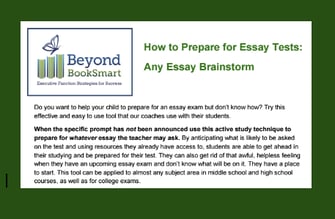Do you have a child who can talk at length on a topic but doesn't know how to develop writing skills, struggling to get all those great ideas down on paper? Because writing draws upon Executive Function skills such as planning, organizing, time management, attention, working memory, and metacognition — it’s no wonder we Executive Function coaches see many of our students struggle in this area. In fact, writing can feel so difficult that just hearing about that upcoming assignment for a 500 word essay can send chills down a student’s back. (Add emotion regulation to the list of Executive Function skills involved in writing!)
on paper? Because writing draws upon Executive Function skills such as planning, organizing, time management, attention, working memory, and metacognition — it’s no wonder we Executive Function coaches see many of our students struggle in this area. In fact, writing can feel so difficult that just hearing about that upcoming assignment for a 500 word essay can send chills down a student’s back. (Add emotion regulation to the list of Executive Function skills involved in writing!)
When it comes to writing and developing writing skills, there really is more to it than just putting words on paper. Let’s take a look at some of the separate components involved to give you a better idea of how complex writing tasks can be.
You can break down the art of writing into these 6 areas: ideas and content, organization, word choice or vocabulary, fluency, voice, and conventions. I’ll explain each of these areas in a bit more detail and offer a strategy for each area.
1) Ideas and Content
Let’s start with ideas and content - the very “stuff” of writing! If a student is struggling in this area, they are having trouble with originality and elaboration. What does that mean? Students may have trouble generating ideas or lack supporting details that offer examples, definitions, or vignettes that help readers cue in to what the writer is saying. If a student is writing a research paper, they may be having difficulty putting ideas into their own words or analyzing and summarizing information they have learned about throughout the research process. If it’s a creative writing assignment, the content may be lacking focus or development of story elements such as plot, setting, theme, or even the main character.
Strategy for creative writing: This article, written by a Speech-Language pathologist contains a detailed, step by step guide for teaching a younger child about how stories are constructed.
2) Organization
Organization is a key writing skill. It might be the process of writing that your child is struggling with. Students need to understand that writing is not a simple assembly-line process; rather, it’s a process that requires not only putting thoughts and paragraphs together, but also a willingness to rework and revisit sections in order to produce a clear and coherent result. Maybe your child starts on one topic, moves on to another, then returns back to the original topic again? This would indicate difficulties with organizing and sequencing their ideas together, which affects overall flow for a reader.
Strategy for organization in writing: This blog post, How to Organize and Essay, 3 Graphic Organizers for Young Writers contains links and other tips to help with different types of writing assignments.
3) Fluency
Another writing skill to develop is fluency, which refers to the amount of words that are generated by the writer. In the opening scenario in this article, the child can verbalize many ideas, but has poor fluency with writing down those ideas and may have difficulty meeting minimum requirements for length of assignments.
Strategies to develop writing fluency: Step by step exercises to build writing fluency.
4) Voice
Voice is the individual writing style that a writer uses and it can be one of the greatest struggles that young writers have. A strong writing voice clearly speaks to the reader and accomplishes an objective, such as helping a reader feel exactly what a character is feeling. Students who struggle with voice in creative writing may tell: “The man got mad.” instead of show their reader information about characters and events: “The man slammed his fists down on the table.” In research papers or essays, students may use an informal tone (“The book is about this kid who’s not so happy.”), which indicates a need to develop a more academic or formal voice for this type of writing.
Strategies to develop voice in writing: Read this article (linked to the left in blue) for an overview of how voice can be developed in young writers. Be patient. Developing your voice as a writer will take time and practice.
5) Vocabulary
Sometimes students have a limited vocabulary, which leads to repetitive and dull writing. Students who struggle in this area will lack grade appropriate words and will simplify what they are trying to say. A student might repeat the same word throughout a story or essay; picture an overuse of the word “big” instead of alternatives such as large, giant, huge, or enormous when describing a dinosaur, for example.
Strategies for building vocabulary: Try vocabulary-focused apps like Vocabulary.com, websites like VocabularySpellingCity, and engaging activities like word games, flashcards, and reading a wide variety of books.
6) Conventions
Let’s take a look at conventions now. When someone says that a piece of writing has convention errors, what they mean is that the piece may have spelling mistakes, punctuation errors, or grammar errors. It is common, especially today with auto correct, for students to make these mistakes and to pay little attention to them while writing or editing themselves. This is an area that requires time and attention to details, which may be challenging for students; especially students that need extra support with Executive Function skills.
Strategy for conventions: Use an editing checklist and then customize it for your child’s trouble spots.
Now what?
So, now that you see some of the separate components of good writing, what else can you do to help your child to develop and hone their writing skills?
First, find out which of these areas are the reason(s) for your child’s writing challenges. Yes, there could be more than one area that a student is struggling with. It may help to talk with your child’s teachers and observe your child’s writing process to get a sense of what may underlie their struggles. If the challenges are substantial, you may consider seeking an evaluation from your child’s school or an outside provider such as a neuropsychologist. Regardless of the problem areas you may be seeing, there are many ways to help a child develop writing skills they will need to become confident writers. Time, patience, and persistence with good strategies can help build the writing skills your child needs to be successful in school and in life.
Please click the link in blue --> for information about Executive Function coaching for Elementary students.
Does your child struggle with essay tests? Download our free guide (click the link below) that helps students prepare effectively for open-ended questions.


